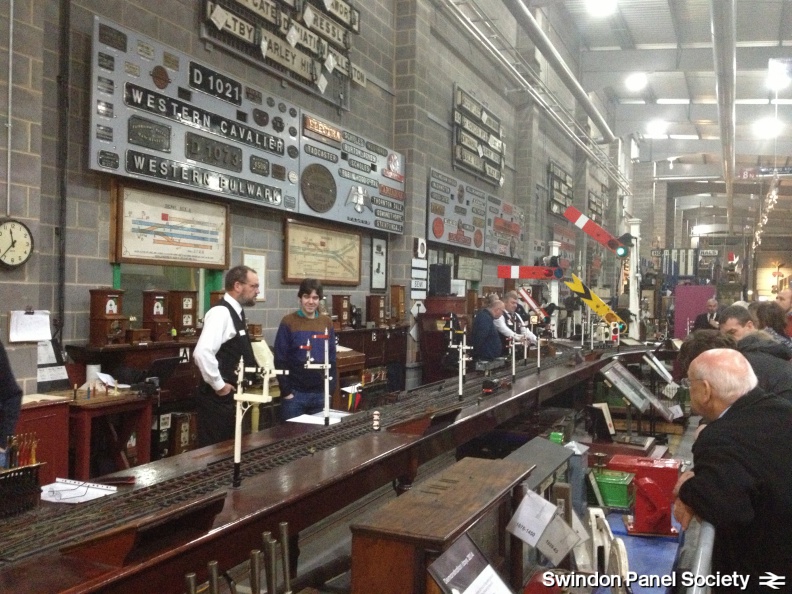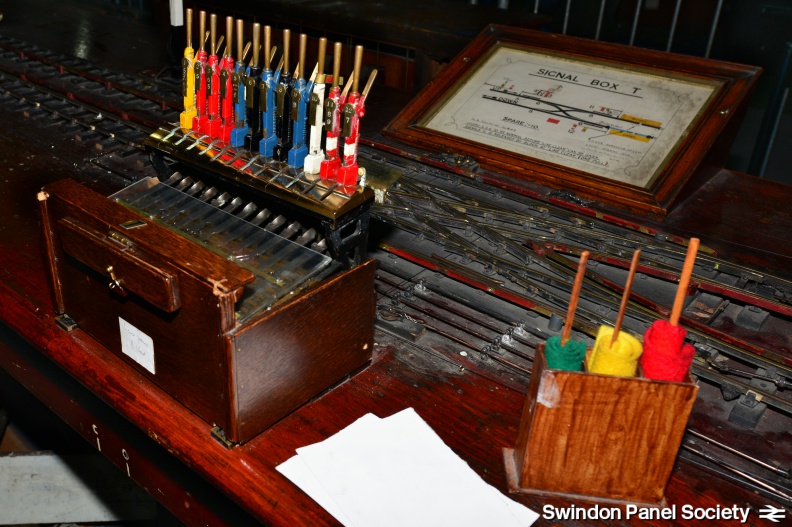What a fantastic day was had by Swindon Panel Society at the National Railway Museum’s Lancashire & Yorkshire signalling school layout!
The layout has four fully signalled and interlocked signal boxes, in very miniature scale, but with full size block instruments and full size regulations!
We took it in turns to work the four signal boxes, with each signal box having their own local nuances and ‘catchers’, just like the real things!
In a very busy timetable that was being operated a very varied selection of operating practices and rules (and bell codes) were used, enough to cause even the most experienced enthusiast or professional signalman to scratch their head! Also, being a model, everything happens much much faster than in real life, so the pace is a lot lot faster – or ‘absolutely insane’ is how several people described it!

As well as the ‘normal’ block signalling between the boxes (all sections are absolute block), with a lot of the sections requiring short-section working, there were also instances of the warning arrangement being used (3-5-5), including displaying a green flag to the model train driver! Permissive acceptance (2-4-2) was also used on a goods running loop between two signal boxes, as well as the rules for permissive working within station limits. Clearing points are also observed on the model layout, with several junctions lying within the clearing point.
Running round in section was also required with their freight train (requiring use of 2-1-3 and 3-2-3!) The freight lives in a siding, worked by a ground frame, released by one of the signal boxes (and it really is a model ground frame electrically interlocked with the model signal box!). The person playing the role of the shunter may have got a bit over-enthusiastic at one point with the number of wagons that could be accommodated for the run-round… So when the time came, and it was found the engine would not fit on the back of the train and be inside clear of the backing signal from which it was now going to depart, the loco driver (radio controlled) pushed the wagons back until the loco was inside clear. This pushed the guard’s van passed the home signal of the next box (which wasn’t off!!) Much laughter followed and the L&Y graciously spared the driver’s career!

There ware also one or two opportunities to practice the emergency regulations as the two-car DMU had a slightly tendency to leave the rails when going over a particular set of points! No need to telephone the RAIB for this though – just reverse back through the trailing points and everything’s re-railed, like all good models!
During the day we were also very lucky to be allowed to visit Borough Market Junction Box.

Everyone had a really excellent time and we thoroughly recommend visiting the layout if you can, and if you get the opportunity to have a go then definitely take it!! Beware of Signal Box ‘B’, that’s extremely difficult!
We were very keen to see how the L&Y team engaged with their visitors, and we learned a lot that we can use when the time comes for Swindon Panel about their commentary and how they pitch their explanations. The L&Y commentators also gave Swindon Panel Society a good plug at the start of each demo to the watching crowds.
At the end of the day we powered up our small demo panel (made by Jon Tillin) which the L&Y team found fascinating. Several members of the L&Y team are ex- or current railway staff in signalling disciplines, and they were keen to ‘test’ our demo panel, and I’m pleased to say they couldn’t fault it!
We hope to be welcoming the L&Y team to a return visit to Swindon Panel in the not too distant future.